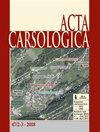On microlocation of submarine karstic sulpur springs near Izola: a small correction makes again a crucial difference
IF 1.1
4区 地球科学
Q4 GEOSCIENCES, MULTIDISCIPLINARY
引用次数: 1
Abstract
In the Slovenian part of the Gulf of Trieste/Trst, submarine springs occur as funnel-shaped depressions in the Holocene sandy-silt marine sediment that forms the seafloor. These springs exhibit both elevated temperatures (up to 29.6 °C) and sulphur content. Based on their location, they are divided into three groups: the Izola group (three springs), the Bele skale group (two springs), and the Ronek group (seven springs). Previous investigations linked these springs to the Izola anticline, characterized by its limestone core and flysch limbs, but no detailed explanation was provided. We propose that: A) sulphur groundwater springs from the limestone (karstic aquifer) at the stratigraphic boundary with the flysch and B) springs occur in the nearshore area, where the sedimentary cover of Quaternary deposits is thin enough to be penetrated by spring waters and washed out. According to existing data, the anticline axis is NW-SE directed, and the Izola group lies approximately on the seaward extension of the axis. Therefore, this interpretation fits perfectly for the Izola group, while the Ronek and Bele skale groups are off-axis extensions and require reinterpretation. In order to resolve the micro-locations of the Ronek and Bele skale groups, we conducted a sedimentological logging of the flysch deposits and detailed geological mapping. The investigations revealed that: A) limestone outcrops occur only in the town of Izola, B) two prominent calciturbidite megabeds that occur in the flysch enable very detailed geological mapping, and C) the axis of the Izola anticline is oriented in the WNW-ESE direction, and this moderate anti-clockwise rotation of the anticline axis explains the micro locations of all springs. The Ronek and Bele skale groups are located on the southern side, and the Izola group is on the northern side of the limestone core of the Izola anticline.关于伊佐拉附近海底岩溶硫泉的微定位:一个小的修正又产生了至关重要的差异
在的里雅斯特/特拉斯特湾的斯洛文尼亚部分,海底泉水在形成海底的全新世砂质泥沙海洋沉积物中以漏斗形洼地的形式出现。这些弹簧表现出高温(高达29.6°C)和硫含量。根据它们的位置,它们被分为三组:Izola组(三个泉),Bele skale组(两个泉)和Ronek组(七个泉)。先前的研究将这些泉水与伊佐拉背斜联系起来,其特征是石灰岩核心和复理石枝,但没有提供详细的解释。我们认为:A)含硫地下水来自于与复理石地层交界处的灰岩(岩溶含水层);B)地下水出现在近岸地区,那里的第四纪沉积盖层很薄,泉水可以穿透并冲刷。根据现有资料,背斜轴为北西-东南向,伊佐拉群大致位于背斜轴向海的延伸上。因此,这种解释非常适合Izola群,而Ronek和Bele skale群是离轴延伸,需要重新解释。为了确定Ronek组和Bele skale组的微观位置,我们对复理石沉积进行了沉积学测井和详细的地质填图。结果表明:A)灰岩露头只出现在伊佐拉镇;B)出现在复理石中的两个突出的钙质辉长岩巨型岩使得地质作图非常详细;C)伊佐拉背斜轴向为WNW-ESE方向,背斜轴的适度逆时针旋转解释了所有泉水的微观位置。Ronek和Bele skale群位于南侧,Izola群位于伊佐拉背斜石灰岩核的北侧。
本文章由计算机程序翻译,如有差异,请以英文原文为准。
求助全文
约1分钟内获得全文
求助全文
来源期刊

Acta Carsologica
地学-地球科学综合
CiteScore
1.50
自引率
14.30%
发文量
0
审稿时长
>12 weeks
期刊介绍:
Karst areas occupy 10-20 % of ice-free land. Dissolution of rock by natural waters has given rise to specific landscape and underground. Karst surface features and caves have attracted man''s curiosity since the dawn of humanity and have been a focus to scientific studies since more than half of millennia.
Acta Carsologica publishes original research papers and reviews, letters, essays and reports covering topics related to specific of karst areas. These comprise, but are not limited to karst geology, hydrology, and geomorphology, speleology, hydrogeology, biospeleology and history of karst science.
 求助内容:
求助内容: 应助结果提醒方式:
应助结果提醒方式:


